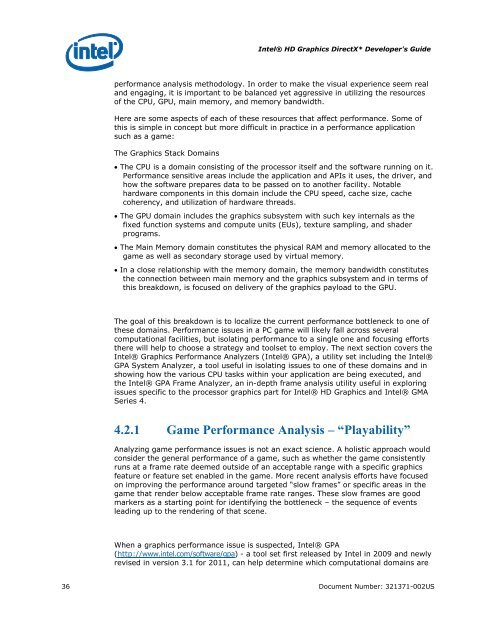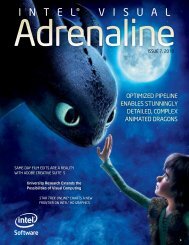Intel HD Graphics DirectX Developer's Guide (Sandy Bridge)
Intel HD Graphics DirectX Developer's Guide (Sandy Bridge)
Intel HD Graphics DirectX Developer's Guide (Sandy Bridge)
Create successful ePaper yourself
Turn your PDF publications into a flip-book with our unique Google optimized e-Paper software.
<strong>Intel</strong>® <strong>HD</strong> <strong>Graphics</strong> <strong>DirectX</strong>* <strong>Developer's</strong> <strong>Guide</strong><br />
performance analysis methodology. In order to make the visual experience seem real<br />
and engaging, it is important to be balanced yet aggressive in utilizing the resources<br />
of the CPU, GPU, main memory, and memory bandwidth.<br />
Here are some aspects of each of these resources that affect performance. Some of<br />
this is simple in concept but more difficult in practice in a performance application<br />
such as a game:<br />
The <strong>Graphics</strong> Stack Domains<br />
The CPU is a domain consisting of the processor itself and the software running on it.<br />
Performance sensitive areas include the application and APIs it uses, the driver, and<br />
how the software prepares data to be passed on to another facility. Notable<br />
hardware components in this domain include the CPU speed, cache size, cache<br />
coherency, and utilization of hardware threads.<br />
The GPU domain includes the graphics subsystem with such key internals as the<br />
fixed function systems and compute units (EUs), texture sampling, and shader<br />
programs.<br />
The Main Memory domain constitutes the physical RAM and memory allocated to the<br />
game as well as secondary storage used by virtual memory.<br />
In a close relationship with the memory domain, the memory bandwidth constitutes<br />
the connection between main memory and the graphics subsystem and in terms of<br />
this breakdown, is focused on delivery of the graphics payload to the GPU.<br />
The goal of this breakdown is to localize the current performance bottleneck to one of<br />
these domains. Performance issues in a PC game will likely fall across several<br />
computational facilities, but isolating performance to a single one and focusing efforts<br />
there will help to choose a strategy and toolset to employ. The next section covers the<br />
<strong>Intel</strong>® <strong>Graphics</strong> Performance Analyzers (<strong>Intel</strong>® GPA), a utility set including the <strong>Intel</strong>®<br />
GPA System Analyzer, a tool useful in isolating issues to one of these domains and in<br />
showing how the various CPU tasks within your application are being executed, and<br />
the <strong>Intel</strong>® GPA Frame Analyzer, an in-depth frame analysis utility useful in exploring<br />
issues specific to the processor graphics part for <strong>Intel</strong>® <strong>HD</strong> <strong>Graphics</strong> and <strong>Intel</strong>® GMA<br />
Series 4.<br />
4.2.1 Game Performance Analysis – “Playability”<br />
Analyzing game performance issues is not an exact science. A holistic approach would<br />
consider the general performance of a game, such as whether the game consistently<br />
runs at a frame rate deemed outside of an acceptable range with a specific graphics<br />
feature or feature set enabled in the game. More recent analysis efforts have focused<br />
on improving the performance around targeted “slow frames” or specific areas in the<br />
game that render below acceptable frame rate ranges. These slow frames are good<br />
markers as a starting point for identifying the bottleneck – the sequence of events<br />
leading up to the rendering of that scene.<br />
When a graphics performance issue is suspected, <strong>Intel</strong>® GPA<br />
(http://www.intel.com/software/gpa) - a tool set first released by <strong>Intel</strong> in 2009 and newly<br />
revised in version 3.1 for 2011, can help determine which computational domains are<br />
36 Document Number: 321371-002US













